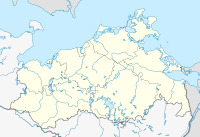Nature reserve Insel Koos, Kooser See and Wampener Reef
Coordinates: 54 ° 9 ′ 32.9 ″ N , 13 ° 24 ′ 26.2 ″ E
The nature reserve Insel Koos, Kooser See and Wampener Riff is a 1560 hectare nature reserve five kilometers north of the city of Greifswald in Mecklenburg-Western Pomerania . The protection on November 5, 1990 with an extension in 1994 serves to preserve an extensive coastal flood and shallow water area of the southern Greifswald Bodden . Shallow water zones, wind flats and grazed coastal flood bogs provide an important habitat for numerous coastal birds. The state of the area is considered to be very good, as the natural coastal dynamics take effect unhindered. The Karrendorfer Wiesen area has been developing naturally again since it was diked in the 1990s. The predator pressure on the breeding birds and illegal recreational use remain problematic. Hiking trails on the Karrendorfer meadows lead to the western part of the area. The island of Koos and the Karrendorfer / Kooser meadows may not be entered. Access to the island by motor vehicle is only permitted for authorized persons.
Territorial division and history
The island of Koos was created as a ground moraine during the last Ice Age . To the north there was a one kilometer long sand hook that separates the Koos Bay from the Greifswalder Bodden. Between the island and the mainland there is the Beek, a narrow branch of water that connects Kooser Bay to Kooser See . This is surrounded by periodically flooded salt marshes (west: Karrendorfer Wiesen, south: Kooser Wiesen) and is shielded from the Greifswalder Bodden by the Streng peninsula. Submarine sand reefs of the Wampener Reef to the east protect the Kooser See from strong waves. In summer drought, the salt content of the lake and the salt pans rises sharply and in some places reaches 30 per thousand (compared to 8 per thousand in Bodden water).
Human use is documented by extensive clearing since the Middle Ages. The area was used as arable land and grassland. The Swedish matriculation card from 1697 shows the surrounding Dutch regions . On the Koos meadows and the island of Koos, the traditional way of using hay meadows, hatching and paddocks has been continued to the present day. In the remaining part of the mainland, trenches were dug from 1800, which can be seen on the original table sheet from 1835. Subsequently, the areas were dyed with a summer dike around 1850. During the GDR era, agricultural use was forced. The Karrendorf-Frätow polder was provided with dikes and drained with drainage and pumping stations . Grain, field fodder and seed grass were grown in intensive agriculture . The bog areas sagged by 20 - 40 cm. The island of Koos served as a target area for fighter bombers in the 1930s, as can be seen from the overgrown impact craters. The water management systems were dismantled in 1993–1994, so that almost 150 years after the first dyke was built, natural flooding conditions prevail again. Cattle pastures in the area are the only use today.
Flora and fauna
The centuries of grazing created its own flora adapted to browsing. Salt grassland dominates with the different zones of a salt marsh . On the Karrendorfer Meadows, there are grasslands on mineral sites. The shallowly dammed silt soils represent extreme locations on which only a few species of macrozoobenthos can live. The nature reserve is of great importance for the bird world. Breeding birds are redshank , ringed plover , dunlin and oystercatcher . In the spring and autumn months there are numerous resting birds. In the last few years, for example, 100,000 white- fronted geese , 10,000 gray geese , 6,000 barnacle geese , 40,000 wigeons , 40,000 long-tailed ducks and 30,000 cape ducks were counted. There are also limestone species such as 12,000 lapwing , 15,000 golden plover , 1,000 dunlin, 1,000 ruff , 600 pygmy sandpiper and 800 wood sandpiper . In ponds on the island of Koos comes Moorfrosch ago. Predatory mammals in the area are weasels , ermine , mink , marten , polecat , otter , badger , raccoon dog , raccoon and fox .
literature
- Koos Island, Kooser See and Wampener Reef 250 . In: Ministry of Environment Mecklenburg-Western Pomerania (Hrsg.): The nature reserves in Mecklenburg-Western Pomerania . Demmler-Verlag, Schwerin 2003, ISBN 3-910150-52-7 , p. 150 f .
- Kooser See and Karrendorfer Wiesen. (PDF; 4.9 MB) In: Small excursion guide for field ornithologists, Birder and Twitcher ... Ornithology Group, Greifswald, 2007, SS 10–11 , accessed on May 6, 2009 .
Web links
- NSG regulation
- Map portal environment of the State Office for the Environment, Nature Conservation and Geology Mecklenburg-Western Pomerania ( information ) with geodata




